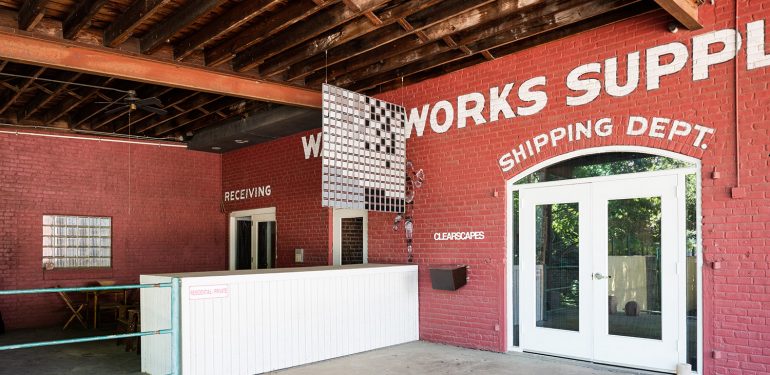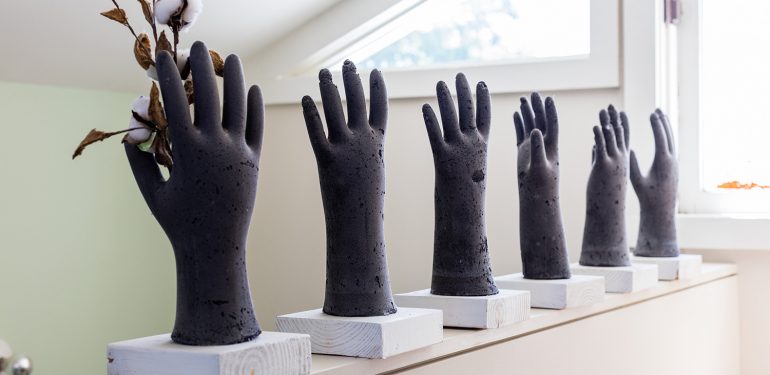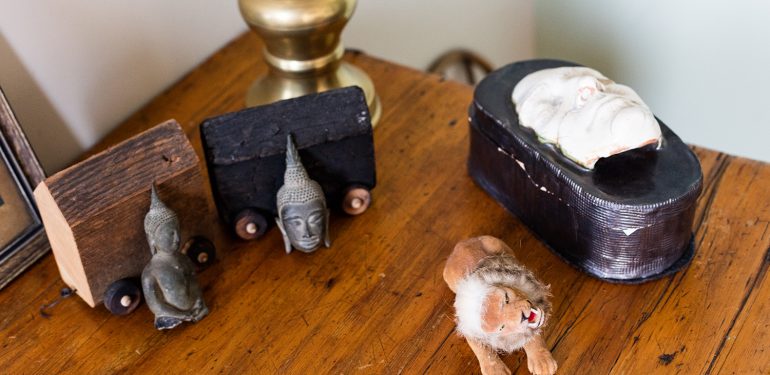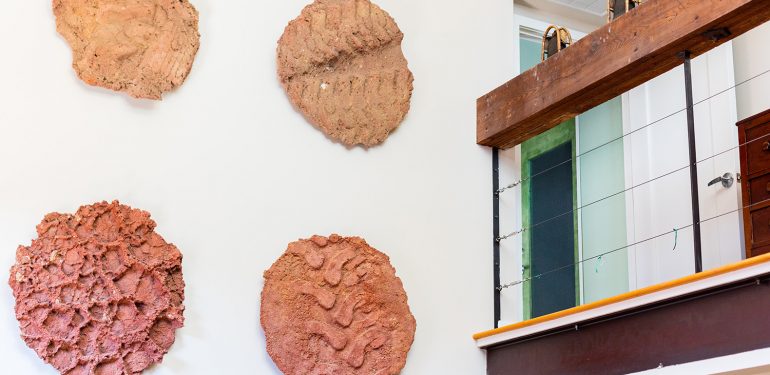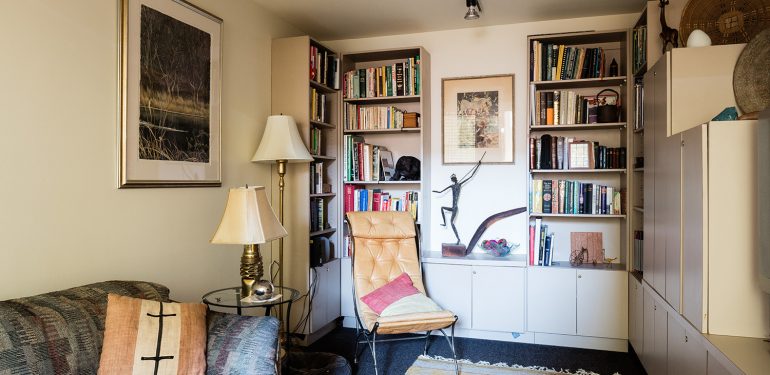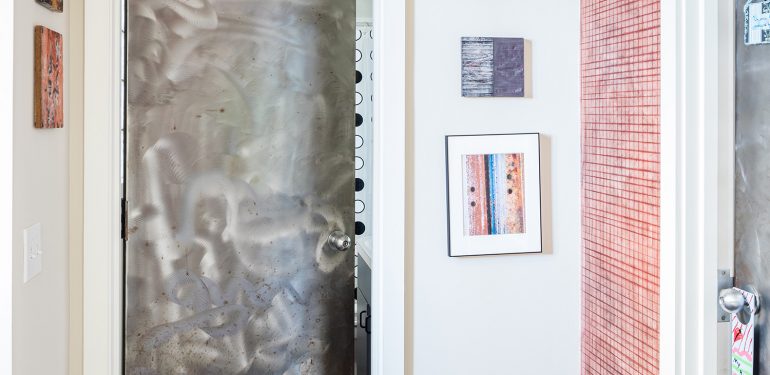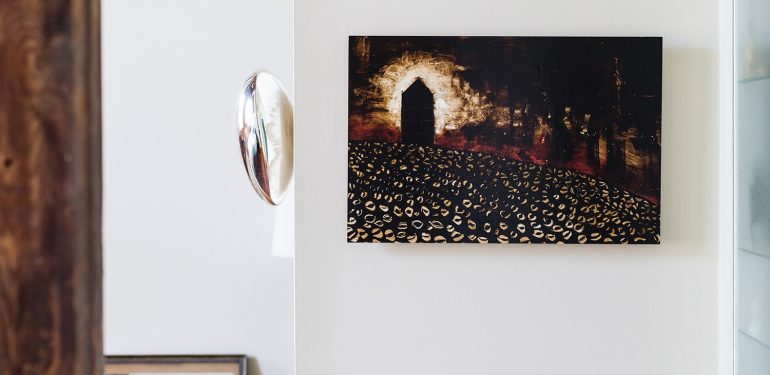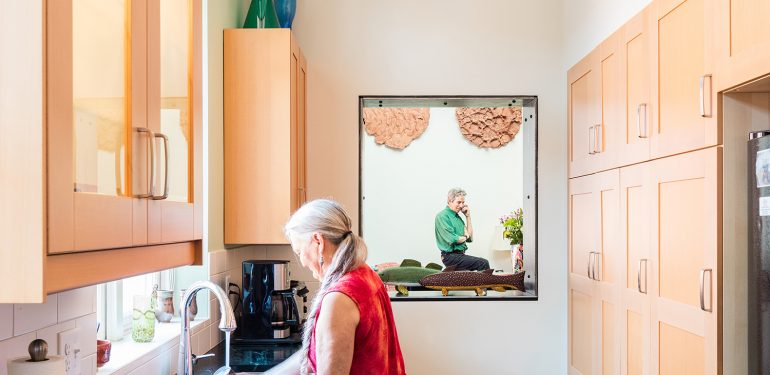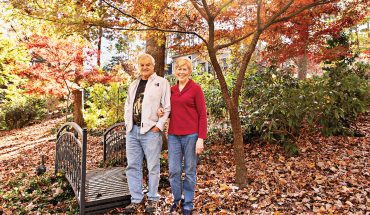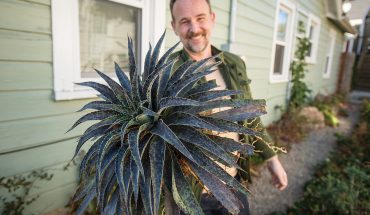At home with Thomas Sayre
by Jesma Reynolds
photographs by Keith Isaacs
On any given First Friday in Raleigh’s downtown Warehouse District, hundreds of art lovers stroll the corridor of West Martin Street that connects CAM to a string of galleries, stopping by to meet artists and see their work. As they cross Commerce Place towards 311 Gallery and the Visual Arts Exchange, most don’t know that the red brick warehouse on the corner is home to someone they’d probably be thrilled to meet: the sculptor, painter and designer Thomas Sayre, whose monumental public art anchors countless public spaces around the world, including the park at the North Carolina Museum of Art.
Since 1991, Sayre and his family have lived there, hidden in plain sight. For that long, a separate space in the former Tom’s Snacks distribution warehouse has served as the residence of Sayre’s business partner Steve Schuster and a third segment of the building has been the site of Clearscapes, the leading architecture, art, and design firm Sayre and Schuster co-founded in 1983.
In this unlikely spot, Sayre and his wife Jed raised their two daughters, Wilson, 26, and Kalyan, 20, hosting play dates, sleepovers, birthdays and all the rituals associated with a growing family. Their decision to move downtown in the early ’90s, they say, was practical, affording them both a studio and a place to live. “My memory is walking across the alley and saying that’s where the studio will be, and thinking, now where are we going to live?” Thomas recalls. Jed’s response: “how about here?” She had grown up in New Jersey and he in Washington, D.C., so the concept of urban living wasn’t entirely new.
They didn’t know then that they’d have to work hard to get it, unraveling a complicated web of 23 heirs to the building with different opinions and multiple leases, deeds, and red tape. Sayre credits Schuster with navigating it all and make the massive building their own.
At the time, the neighborhood around it was industrial and rough. The only people on the street at night were drug dealers and male prostitutes, Thomas says. Occasionally, the couple would go out on their roof and pellet loiterers with water balloons just to let them know they were living there. Raising children in such an environment, needless to say, posed its own kind of challenges. “It was our first kid,” Jed says. “You didn’t even know what to think about. I had to go down and negotiate about school. This area wasn’t zoned for a school district.”
But with ingenuity and resilience, it became a fantastic place to grow up. The Clearscapes parking lot, dirt at the time, became a giant playground for bike ramps and jumps; the arrival of a construction crane downtown meant a new play structure to discover. When Thomas’s band Spot played at Kings or The Berkeley Cafe, the whole family would make it a night out, complete with Shirley Temples for the girls.
Not all parents of their girls’ friends were as enthusiastic about the location as the Sayres. “There were a few tense moments on the cell phone with sleepover deliveries,” Thomas recalls, “parents parked outside saying ‘we can’t be in the right place.’ But once they came inside, they realized it was okay.”
Art, light, quiet
Inside the Sayre home, it was—and is—more than okay. Soaring twenty-one-foot ceilings of exposed brick showcase Sayre’s prolific work. The earthcast sculptures that have made his name and are the subject of the recent Emmy-nominated documentary, Earthcaster. hang from the walls; so do paintings from his recent White Gold series, Valentine’s Days offerings, and collections of his daughters’ shoes through the years mounted on boards to document their growth.
Gleaming metal doors hand-ground by Sayre and giant 1910 wooden trusses anchor the rooms. The space is intimate, reverential and remarkably quiet. As light pours in through high-set windows in a way that feels like a medieval cathedral, one can easily forget the massive construction and redevelopment projects underway less than a block to the west.
The growth those projects represent is reflected in the different experiences the Sayre daughters had growing up. Wilson, the oldest, found little to do in what was then a mostly industrial area within a sleepy downtown core. Her teenage years revolved around school and extra-curriculars. But by the time youngest daughter Kalyan was in high school, the transformation of downtown was well underway. Shops, restaurants, festivals, and events made her house an ideal place to be. She and her friends could walk (no cars needed) to just about every cool spot: Morning Times, Father and Son Antiques, Kings, the Berkeley Cafe. Events like First Fridays, Hopscotch, the Fourth of July, and First Night filled her calendar. “I think what was unique about my upbringing,” Kalyan says, was “knowing how to independently navigate and walk around from an early age. It’s something that has allowed me to learn how to live in a city on my own.”
As the couple have become empty nesters and contemplate living in the now-booming city on their own, they are contemplating their next move. “My vision for retirement is that we travel and stay, so when we come back here it’s new and different,” says Jed. Thomas yearns for a quieter place, somewhere more connected to the land where he can “encounter God, witness the rhythm of the sun coming up and down, walking and camping.”
As Raleigh continues to grow and change, their decision may, too. In the meantime, the Sayres are still getting used to the fact that it’s been 26 years since they made the leap of faith to move into an old warehouse in an industrial neighborhood, to raise their children, make their art, grow their business. But to hear them tell it, it was worth it, all of it.

